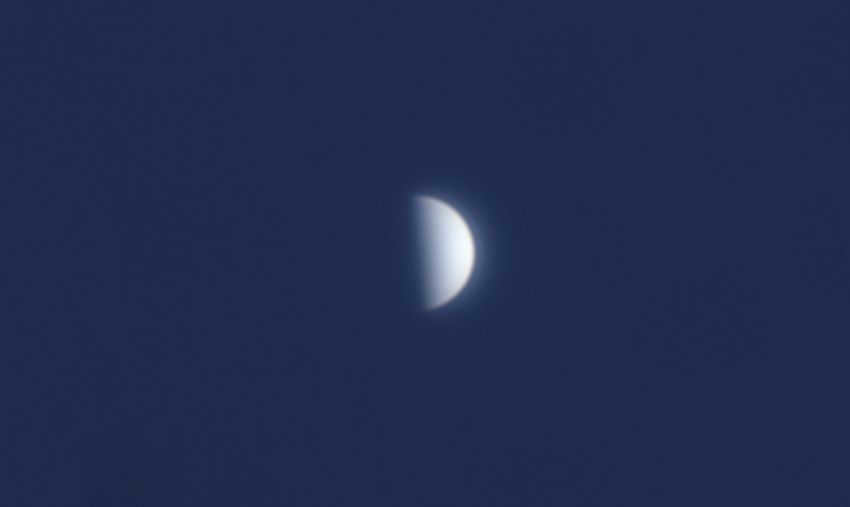The Obuchonok site is a treasure trove of research papers and projects created by students. It also showcases the themes of various creative projects and provides guidelines for their design. Additionally, it offers educational programs specifically designed for children.
Banner code:
Explore the world of research papers and projects
Discover the intriguing project titled “Unveiling the mysteries of starlight in broad daylight”

The author of the research project titled “Characteristics of starlight during the daytime” explores the phenomenon of stars, their luminosity, color, and provides a classification.
During the investigation of the surrounding world, a first-grade student aimed to understand the peculiarities of starlight during the daytime by observing the starry sky both in the darkness and brightness of the day. Additionally, the student conducted a literature review on the topic of research.
More information about the project:
At the heart of the investigation into the world around us (for elementary school students) titled “Characteristics of starlight during the day” lies the quest for understanding the nature of stars. Through extensive research using both encyclopedic sources and the internet, the author aims to unravel the mysteries surrounding stars, including their composition, organization, and the reasons for their illumination in the night sky.
In the proposed project on the environment (for elementary school students) titled “Distinctive qualities of starlight during the day,” the author has diligently gathered and examined information pertaining to the birth of stars, the unique properties of their light during both daytime and nighttime, and has even included the findings of a small experiment as an addendum to the project. This experiment serves as evidence that stars do not vanish during the day, but rather diminish in brightness.
Table of contents
Introduction
1.Secrets of the celestial canopy
1.1.What constitutes a star
1.2 The genesis of stars
1.3.Unraveling the enigma of stellar radiance
1.4.Stars categorized
1.5.The stellar hues
2.Do stars vanish from the firmament during daylight hours? Examining the phenomenon of light
Conclusion
List of references utilized
Appendix
Introduction
Every individual has an affinity for gazing at the celestial bodies. We frequently observe them in the night sky, captivated by their unique and enchanting radiance. In ancient times, our ancestors believed that these celestial entities held sway over our destiny and future. Some individuals simply appreciate the ethereal beauty of the nocturnal sky, while others strive to unravel the enigmas of the universe.
What exactly are stars? How are they arranged? Why do they illuminate the sky? These inquiries have long intrigued humanity. Scientists and astronomers have conducted extensive research and made numerous discoveries. Books have been written and informative films have been produced about stars, and yet, many remain unaware of the secrets concealed within the starry expanse.
Relevance of the Problem: Where do the stars vanish during daylight hours?
Problem: Is it feasible to perceive the radiance of stars during the daytime?
Object of study: The starry sky.
Subject of study: starlight.
Research Methods:
The goal of my research is to examine the characteristics of starlight during daytime.
- To conduct observations of the starry sky during both day and night;
- To review relevant literature on the subject;
- To determine the properties of starlight;
- To perform an experiment to measure the intensity of starlight in the daytime and nighttime sky;
- To draw conclusions about starlight during the day and night based on the results of the experiment.

Stars do not vanish, they simply become invisible in the daytime due to the overpowering brightness of sunlight.

The stars remain invisible to us during the day due to the overwhelming brightness of the sun, which illuminates the Earth and conceals the celestial wonders of the cosmos.

What happens to insects during the autumn season?
What is the fate of insects in the fall?

Over the ocean?
Twice annually, during the lengthiest days of the year.
Made from pliable willow bark and reeds.

Can you suggest metaphors for the following words: time, sky, sunbeam, month, stars, night, day?
Would you be able to come up with metaphors for the words: time, sky, sunbeam, month, stars, night, day?

What are the primary occurrences in the narrative Stars in the Rain?
The primary occurrences in the fable Stars in the Rain.
Compose antonyms for the specified terms?
Compose antonyms for the specified terms.

What is the meaning of Pushkin’s poem titled “The Daylight has gone out”?
Can you explain the subject matter of Pushkin’s poem called “The Daylight has gone out”?

9. The place where the witch Solokha concealed the stars
9. Where were the stars hidden by the witch Solokha? 9.
Is it true that happiness can make gray hair vanish, dissolve like frost in the sun?
Gray hair vanishes, dissolves like frost in the sun when there is joy.
It is a rare occurrence, but it does happen."
Why doesn’t gray hair always "vanish"?

Could you assist me in creating a riddle related to the stars?
I need some help in coming up with a riddle about the stars.
Zhukovsky?
What are the lines in the riddle about the sky that imply the eternal nature of the stars and the sky?
A bridge with a pearly hue
Constructed over the waters.
Many a ship has sailed beneath it;
But on its gleaming crest
If you approach, it eludes your grasp
With its current, it is brought forth
You have arrived at the inquiry regarding the whereabouts of the stars during the daytime, which falls under the Literature category. This question is of moderate difficulty and is suitable for students in grades 5 – 9. Within the same category, you will discover answers to other related questions on this topic by utilizing the convenient “smart search” feature. Engaging insights can be found within the comments and responses shared by users, providing an avenue for further discussion on the subject. If the provided answer choices do not meet your requirements, feel free to formulate your own query using the search bar at the top.

School darling is already 80 years old, and yet you remain forever young. I have an exclusive affection for you, an eternal love that will never fade. The memories of the way you nurtured me, the knowledge you imparted to me will always stay with me. I will never forget the invaluable lessons I learned in your hallowed halls. Oh, dear school, you will forever hold a special place in my heart.

Honor is the embodiment of a person’s admirable and esteemed moral qualities, which are deserving of both respect and pride. It is a concept that can be interpreted differently depending on cultural or social traditions, as well as individual motivations and circumstances…

The stars disappear during the day, but they come out at night.

It was unfortunate that he suffered from sleep deprivation and eventually passed away in his chilly bed.

In 1831, Alexander Sergeevich Pushkin penned the famous story “The Tale of Tsar Saltan,” which was published the following year. This literary masterpiece quickly gained popularity and became beloved by countless readers. Despite the passage of time since its creation…

Unceasing acts of kindness have the power to create miracles. Similar to how the sun’s warmth can cause ice to melt, acts of kindness can dissolve misunderstandings, suspicions, and animosity.

Wilfrel Ivanhoe is the main character in this story. 1. The origin of the hero. (Ivanhoe comes from an ancient Saxon family. His father, Cedric Sax, is a member of the noble class who refuses to align with the Normans and dreams of an independent and self-sufficient…

Introducing the most amazing fairy tale Kolobok. Discover what fate had in store for him and delve into the sequel to this enchanting story. Don’t let this opportunity slip away. Join us for an unforgettable experience.

The Battle of Borodino was a significant event during the War of 1812. It shattered the myth of Napoleon’s army’s invincibility and played a crucial role in reshaping the French army due to the significant sacrifices made during the battle. This battle marked a turning point in the war and had a lasting impact on the outcome.
© 2000-2023. All rights reserved. The use of materials from this site requires proper attribution. Viewer discretion advised.
This site is protected by reCAPTCHA technology, and Google’s Privacy Policy and Terms of Use apply.

What are the characteristics of the visual system of diurnal birds of prey?
List the characteristics of the visual system of diurnal birds of prey.

What is the essential requirement for water to move upwards in a plant?
What is the essential requirement for water to move upwards in a plant?
1) Absence of water evaporation
2) Continuous water evaporation

Why are the seasons each 3 months long and why can’t one season be longer than another?
Why are the seasons each 3 months long and why can’t one season be longer than another?

What is the reason behind the longevity of forests?
What is the secret to the long existence of forests?

How do pigeons, lynxes, dolphins, starfish, earthworms, moles, ascarids, and plants adapt to their environment?
Pigeons, lynxes, dolphins, starfish, earthworms, moles, ascarids, and plants have various adaptations to thrive in their respective environments.

How does a penguin move when swimming?
Explain the way a penguin moves while swimming.

Create groups of names, for example dolphin, stingray, caterpillar, starfish (which one is the odd one out?
Create sets of names like: dolphin, stingray, caterpillar, starfish (which one is excluded?

Can you write a report about starfish?
I would like you to write a report about starfish.
However, please avoid taking information directly from a single website.

What is the reproductive method of protozoa in both favorable and unfavorable circumstances?
Which reproductive method is typical for protozoa in both favorable and unfavorable circumstances?

Why is light important for plants and animals?
Why is light important for the survival of plants and animals?
Provide examples of plants that thrive in well-lit areas, plants that can tolerate shade, and plants that prefer shade.
Provide examples of animals that are active during the day and animals that are active at night.
Can we distinguish between drought-tolerant plants and plants that require moderate moisture based on their appearance?

Only gases have the ability to pass through the stomata. These gases include carbon dioxide, which is essential for photosynthesis, and oxygen, which is necessary for respiration. Oxygen is produced during photosynthesis, while carbon dioxide is released during…

It is the higher nervous system that is accountable for the brain’s mobility and the activities that we carry out.

The star on my abdomen disappears.)

It is the sole seed pod of cereal crops.

The stigma serves as the sole receptacle for grains. The solution is 2.

Carl von Linnaeus (1707-1778), the renowned Swedish naturalist and botanist, emerged as the most influential scientist during the pre-Darwinian era of biology. Despite being a creationist, Linnaeus made significant contributions to the field of biology. In 1735, he published his seminal work, The System of .

Responses – 2 – 2, 3 – 2, 4 – 3, 5 – 2, 6 – 1.

The physiological norm refers to the range of values within which the organism can function normally without any disruption to its vital activities. Therefore, any deviations from the normal composition of the body’s internal environment, exceeding the physiological norm, can be harmful as they disrupt the established balance…

The movement of stars during the day is influenced by the difference in salt concentration between the middle and bottom of the cell. Diffusion occurs against the concentration gradient, as water moves from areas of lower concentration to areas of higher concentration.
© 2000-2023. It is mandatory to provide a reference when using any materials from this site. 16+
This website is protected by reCAPTCHA technology, and is subject to Google’s Privacy Policy and Terms of Use.

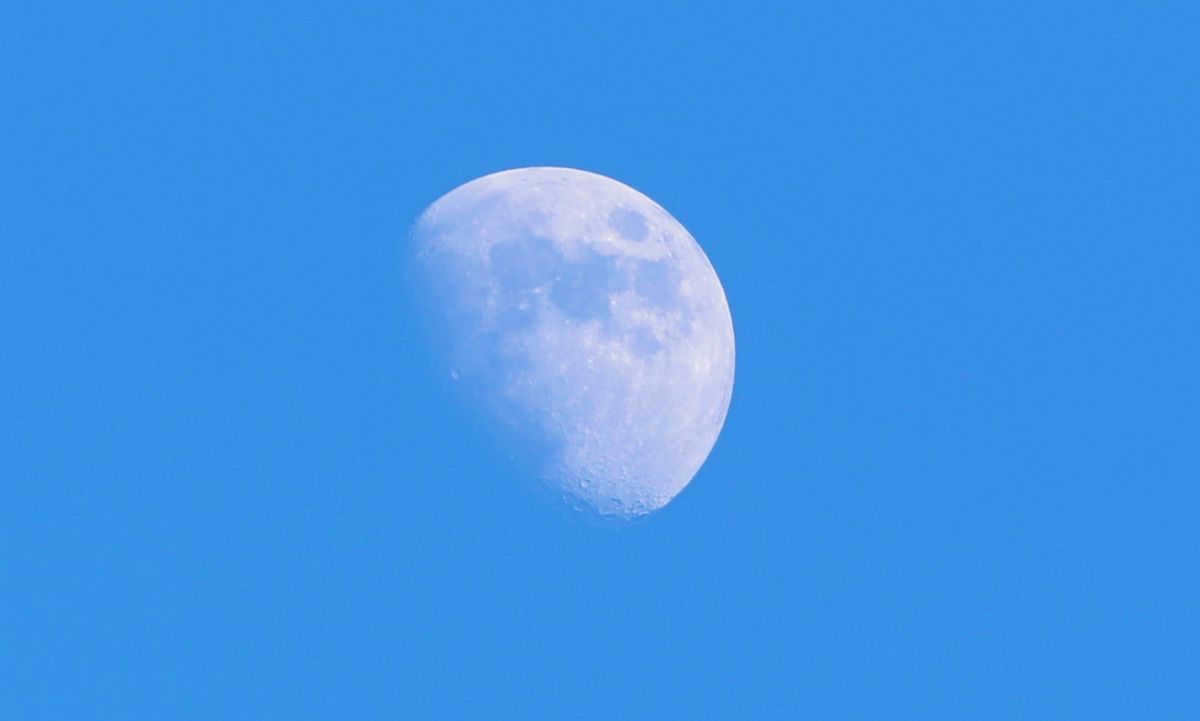
Solar System
Although the Moon is typically associated with the night sky, it is not uncommon to spot it during the day against a backdrop of clear blue. This phenomenon can be observed with a basic understanding of astronomy and a touch of luck, revealing the presence of other celestial objects alongside the Sun.
Factors influencing the visibility and concealment of celestial objects
Out of all the stars in the galaxy, the Sun, being the closest to Earth, is the most prominent one in our solar system. Its proximity allows it to shine the brightest, even though there are other stars in the galaxy that outshine it. With hundreds of billions of stars in the galaxy, the majority of them are classified as faint. As an object moves farther away from Earth, its light diminishes in intensity, making it less perceptible to the naked eye.
Stars and other celestial bodies are not visible during the day. When the Earth orbits around the Sun, the sunlight is so intense that it makes it physically impossible to see the stars in the sky. The brightness of objects is the key factor. The Sun, for example, has a stellar magnitude of almost -27. In contrast, the full Moon emits visible light of -13. Other objects are even dimmer. This is why it is challenging to observe anything in the sky when sunlight is bright.
However, there are certain circumstances under which some space objects can be seen during the daytime. These include the Moon, Venus, Mars, Mercury, Jupiter, and even the International Space Station. These objects appear brighter compared to the stars, which is why they can be visible in the daytime.
One of the most fascinating celestial bodies to ponder is the Sun. Despite its daily presence in the sky, visualizing the actual appearance of its surface is a challenging task. The culprit behind this difficulty is the Sun’s intense, blinding radiance. As a result, it is strictly prohibited to gaze directly at the Sun without the aid of specialized equipment, as it can cause severe damage to one’s eyesight. This cautionary measure is particularly crucial during solar eclipses, when the desire to witness a genuine marvel is at its peak. To safeguard your eyes, it is recommended to utilize light filters – whether they are professionally manufactured or homemade. On certain occasions, when atmospheric conditions create a haze, a natural light filter is naturally formed, enabling observers to perceive prominent spots on the Sun’s surface.
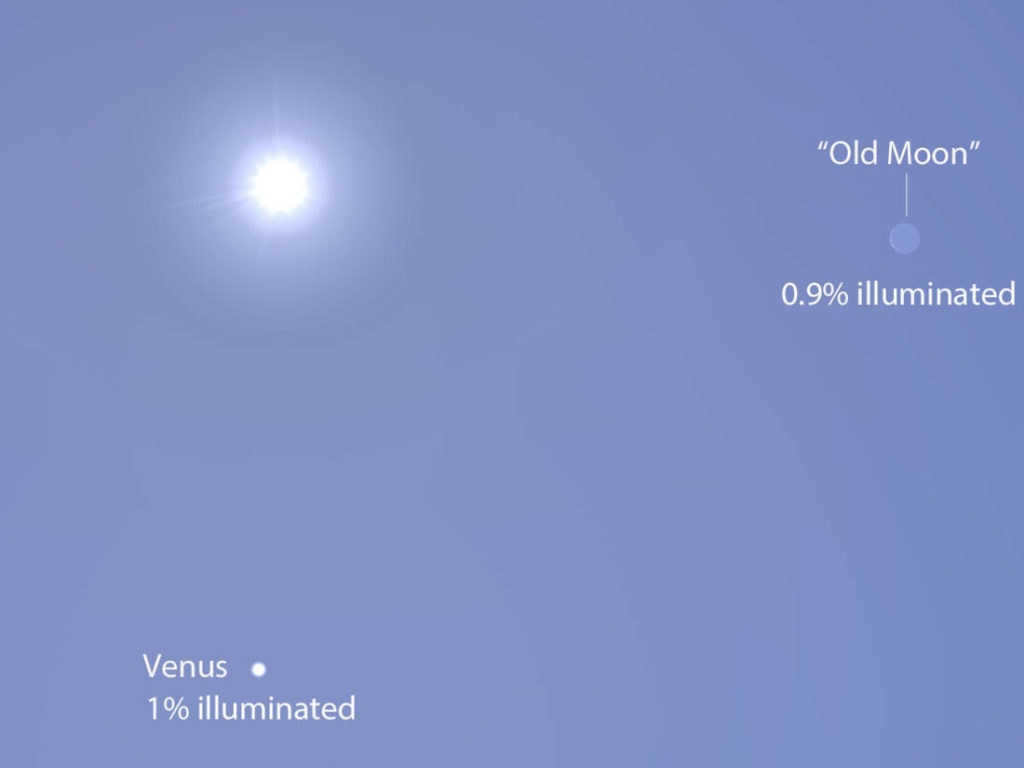
In addition to the Moon, Venus can be observed in the sky during the day, although it may be a bit more challenging. Despite emitting a brighter light, the planet appears as a small white dot to the naked eye because of its smaller size. Occasionally, it takes on the form of a bright, thin crescent that can even shine through clouds. To spot Venus, you must look towards the west or east of the Sun, at an angle of 20-50 degrees.
Another interesting type of celestial objects are those created by humans. The International Space Station (ISS), for example, is quite difficult to see during the day. However, there is a group of satellites called Iridium that can be observed. These satellites are easily noticeable in the night sky, but they can also be seen when illuminated by the Sun. This is because they periodically produce flashes of light, caused by the reflection of sunlight off their antennas. This phenomenon even has a specific name – Iridium flashes.
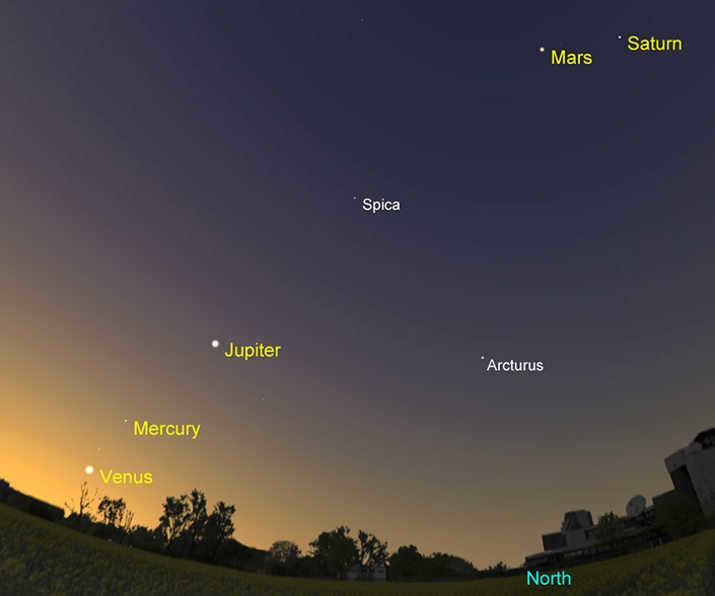
When is it possible to observe the Moon during daylight hours?
It is quite common to see the Moon in the sky at the same time as the Sun – it is visible almost every day. However, there are exceptions when the Moon is approaching the phases of full moon and new moon. This is because during the full moon, the Moon is located on the opposite side of the Sun. Moonrise occurs at the same time as sunset, making it impossible to see the Moon during the day. Similarly, during the new moon phase, the Moon is closest to the Sun and its unlit side faces the Earth, making it invisible.
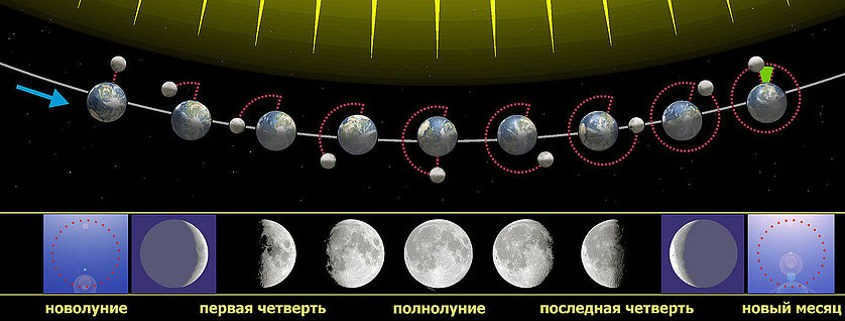
During other occasions, the Moon can be easily seen during the daylight hours with the unaided eye. If the Moon is in its waxing phase, one should observe the sky in the east during the afternoon, whereas if it is in its waning phase, one should look towards the west during the first half of the day. The Moon becomes visible due to its position, which is 90 degrees away from the Sun. Consequently, the light is cast from the side, giving the Moon the appearance of a semi-circle.
You can attempt to capture an image of the satellite during the daylight hours using a smartphone, a basic camera, or a professional camera – it will be easily distinguishable in the photographs. When observing the Moon through a telescope, the craters can be seen just as clearly as they are at night. The contrast against the blue sky makes the image much more captivating. Interestingly, by taking multiple photographs at intervals of 24 hours, it is possible to track the Moon’s libration, which refers to its slight wobbling motion. This phenomenon allows for 59% of the satellite’s surface to be visible from Earth.
Did you know?: In July 2013, photographer Thierry Legault achieved a remarkable feat by capturing an incredibly thin crescent moon just 4 degrees away from the Sun. Legault utilized professional equipment and even created a homemade device to block out the sun’s glare and successfully capture this unique shot.
When it comes to the Moon’s visibility during the daytime, it is fascinating to consider the occurrence of a solar eclipse. During this extraordinary astronomical event, the Moon partially or completely blocks out the Sun. For a solar eclipse to happen, the Moon must be in its new moon phase, where its unlit side faces the Earth. While the Moon itself remains unseen, its gently undulating silhouette can be observed against the backdrop of the penetrating sunlight.
Characteristics of the atmosphere
The atmosphere and its characteristics are responsible for the intense sunlight that surpasses all other celestial bodies. In reality, the sun emits a vibrant white light. Nonetheless, as this light travels through the atmosphere, it becomes scattered and acquires a yellow hue. On exceptionally clear days, when the sky displays a stunning blue hue, the white light can still be observed.
Atmospheric optics explores various other inquiries as well. For instance, it elucidates the reasons behind the varying shades of clouds based on weather conditions and the time of year. It also delves into the origins of mirages and the occurrence of the moon appearing blue, among many other phenomena.
Fascinating piece of information: In exceptional circumstances, stars can even be observed in the sky during daylight hours. During a solar eclipse, the brightest stars, such as Sirius, may become visible. This phenomenon has had numerous advantages for both history and science.
During the daytime, it is possible to observe the Moon and other celestial bodies as long as they are sufficiently distant from the Sun and not overshadowed by its radiance. This occurrence is primarily attributed to the luminosity of astronomical entities, with the Sun holding the foremost position, as well as their proximity to Earth. The Moon, for instance, can be witnessed on most days (excluding the full moon and new moon phases) due to its position approximately 90 degrees away from the Sun, allowing it to be illuminated by the Sun’s radiance from the side.
If you come across any errors, kindly highlight the text segment and press Ctrl+Enter.
Not many individuals are unaffected by the view of the evening sky in May. Just one hour after the sun has set, a brilliant white star can be seen in the western part of the sky. As the night grows darker, it becomes even more radiant, outshining even the genuine stars! Another notable distinction from regular stars is its steady and calm luminosity. It barely flickers at all, unlike the other lights in the vicinity. This begs the question: what exactly is this object? Could it be a planet? What is the identity of this luminous star that appears in the western sky during May evenings?
The most brilliant celestial body visible in the nighttime firmament during the month of May in the year 2023
Undoubtedly, it is none other than the planet Venus! Since the start of February, Venus has held the position of being the most prominent celestial object in the evening sky, and it continues to maintain this distinction for the fourth consecutive month. Venus remains situated in the western part of the sky for the entirety of the first half of 2023, and it becomes observable after the sun has set. (In August, it will transition to the morning sky, where it will radiate its luminosity throughout the autumn season and a significant portion of the winter season.)
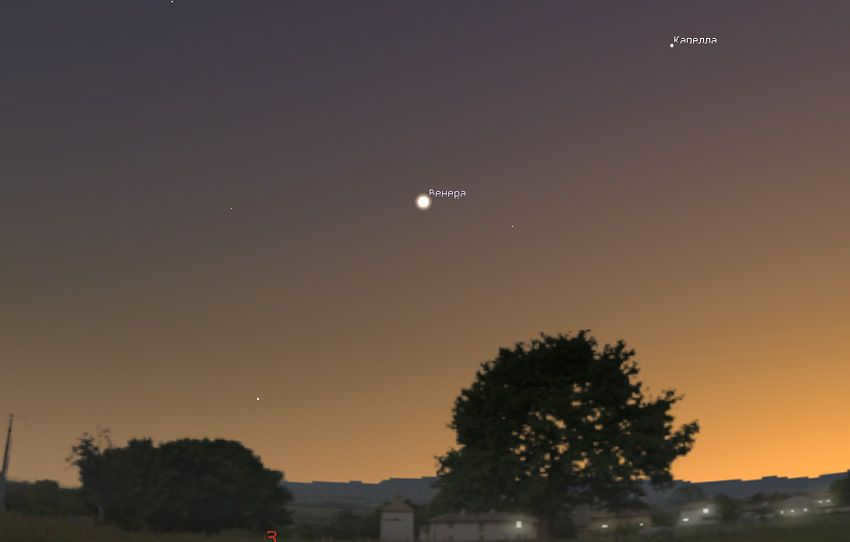
Venus is highly luminous even during the early stages of twilight, when the stars are just beginning to appear in the celestial sphere. Figure: Stellarium
Venus is such a radiant celestial body that it can be easily discerned in the atmospheres of most major metropolises. Neither urban illuminations nor atmospheric pollution pose as hindrances to the observation of this planet. The only constraint lies in its relatively low altitude in the heavens. In the month of May in the year 2023, Venus remains visible for approximately 3 hours after sunset, although during the latter hour and a half it assumes a rather diminished position just above the horizon. In sprawling cities with closely packed buildings, it may become obstructed by the presence of houses and trees.
Venus in May 2023
With its luminosity, Venus frequently acts as a guide to other planets, the most brilliant stars, and even entire constellations. Venus simplifies the task of locating the planet Mercury when it emerges nearby. Furthermore, as spring draws to a close, Mars is relatively proximate to the Evening Star (as Venus is commonly referred to).
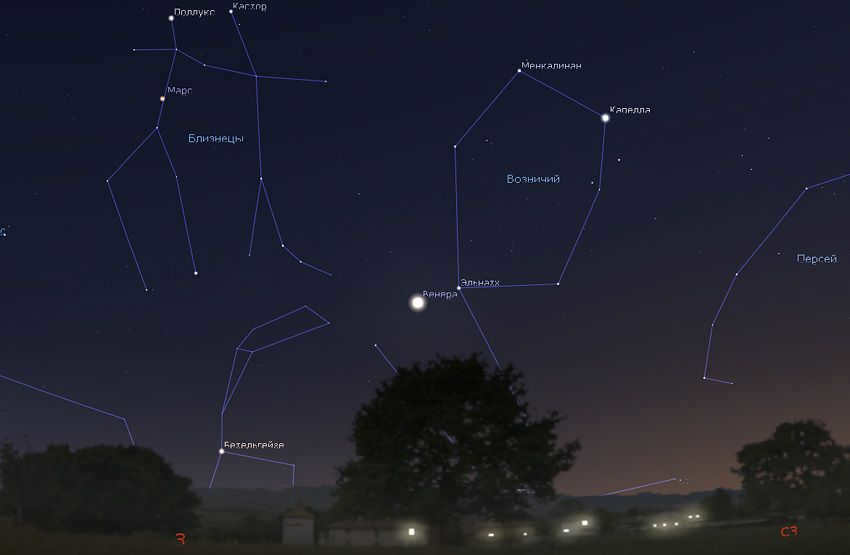
In the evening sky of May 2023, Venus can be seen along with the constellations surrounding it. This information is provided by Stellarium.
During the month of May, Venus will move through two different constellations. In the first week, it will be in Taurus, and then it will move into Gemini. On May 1st, Venus will pass south of El-Nath, which is the beta star of Gemini. In the second half of the month, Venus will be in a race with Mars to see which planet can move faster against the backdrop of the stars. This competition will continue into June, with Mars ultimately being the winner. Venus will come within 3.5 degrees of the Red Planet before turning back towards the Sun.
Venus through a Telescope
When observed through an amateur telescope, Venus presents itself as a dazzlingly bright and small snow-white disk. It displays phases similar to that of the moon. In the beginning of May 2023, Venus will resemble a waxing moon that has passed the first quarter phase, but has not yet reached the full moon stage. At this time, Venus will have an apparent size of 17″. It is important to note that the planet is enveloped in a dense layer of clouds, making it challenging to discern any features on its surface. To overcome this obstacle, special light filters are commonly used when observing Venus. These filters help to decrease the planet’s brightness and enhance the visibility of details. Venus is often observed during early twilight or even at sunset, when the sky background is not as dark.
